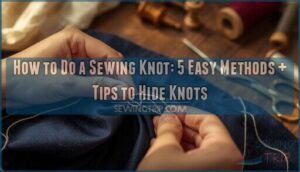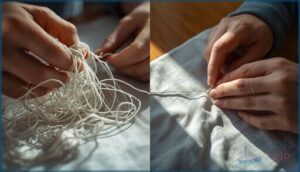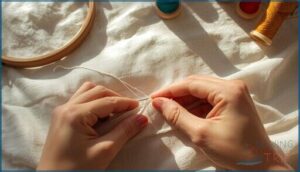This site is supported by our readers. We may earn a commission, at no cost to you, if you purchase through links.
Your thread keeps slipping through the fabric right when you’re mid-stitch. The tail unravels. Your seam gaps open. A solid sewing knot solves all of this, yet most beginners either tie theirs too loosely or bury them in the wrong spot.
The difference between a knot that holds and one that fails comes down to technique—how you wrap the thread, where you position it, and how much tension you apply. Once you learn to secure your thread properly at the start and finish of every seam, you’ll stop re-stitching the same line three times.
These five methods cover everything from the classic finger-wrap knot to hidden loop techniques for embroidery.
Table Of Contents
Key Takeaways
- A solid sewing knot prevents thread from unraveling mid-stitch, and the key is proper technique—how you wrap the thread, where you position it, and how much tension you apply.
- The finger knot method involves wrapping thread around your finger twice and rolling those loops off with your thumb, while the needle twirl method wraps thread 3-4 times around the needle shaft for faster, more controlled results.
- Locking stitches and loop knots offer knot-free alternatives that create flatter finishes—take two or three tiny backstitches in the same spot, or use a loop knot with folded embroidery floss for clean starts.
- Hide knots by tucking them 6-12 mm inside seam allowances, popping them into batting layers for quilting, or weaving thread tails under existing stitches on the back of embroidery work.
How to Tie a Basic Sewing Knot
A solid sewing knot is the foundation that keeps your stitches from unraveling halfway through a project. Getting this right from the start saves you from frustration later.
A solid sewing knot is the foundation that keeps your stitches from unraveling halfway through a project
Let’s walk through the essential steps to create a knot that holds tight every time.
Threading The Needle Properly
Threading the needle is your first move before you tie any sewing knot. Cut your thread to forearm length—fingertip to elbow—to avoid tangles during hand sewing. Trim the end cleanly at an angle for easier insertion, and hold the thread steady while guiding the needle eye toward it.
- Match needle sizes to your thread weight
- Use ergonomic lighting to see the eye clearly
- Condition thread with beeswax to reduce fraying
- Hold the thread short for better hand position control
To guarantee the best results, consider the proper thread techniques for your project.
Making a Secure Starter Knot
Now you’re ready to form your starter knot. Hold the threaded needle in one hand and wrap the thread around your finger twice, then roll those loops off with your thumb to create a tight knot at the tail.
This method works for most woven fabrics, but loose-weave materials may need a triple knot for extra security against slipping through.
To master various knotting techniques, understanding the basics of sewing thread knots is essential.
Tips for Tightening and Placing The Knot
Once you’ve formed your knot, place it within 1 to 2 millimeters of the fabric surface—flush but not compressing the weave. Pull with steady, controlled tension rather than yanking; aggressive tightening can pucker lightweight fabrics or snap fine thread.
For heavy canvas or loose weaves, match your thread selection and knot size to the fabric. Trim the tail to a few millimeters after secure tightening.
Finger Knot Method Step-by-Step
The finger knot method is one of the most popular ways to start your sewing. It takes a little practice to get the rolling motion down, but once you’ve got it, you can tie a knot in seconds.
Let’s walk through the technique and talk about what can go wrong.
Rolling and Sliding Off The Knot
Once you’ve wrapped the thread around your finger, here’s where knot formation really happens. Keep your wraps snug but not tight—you need the thread to glide smoothly. The rolling techniques and sliding motion work together to create a secure sewing knot right at the thread’s end.
- Roll your thumb pad firmly along your wrapped finger while pulling the long thread tail straight away—this twisting action transforms those loops into a tight thread knot.
- Guide the emerging knot with your opposite hand’s middle finger as it slides off your fingertip to fix it precisely where you want it.
- Maintain even thread tension throughout the roll—uneven pressure causes the knot to loosen or slip under stress.
- Position wraps closer to your first finger joint for better control during the sliding motion, reducing hand strain in longer knotting and stitching sessions.
These ergonomic tips help you place knots consistently within a few millimeters of the tail end every time.
Common Mistakes to Avoid
Frustration builds when your finger knot refuses to behave. Here’s what trips up most beginners and how to sidestep those sewing errors:
| Mistake | Problem It Creates | How to Fix It |
|---|---|---|
| Thread too long (over 75 cm) | Tangling and thread tension inconsistencies during knotting methods | Cut thread from hand to elbow—shorter lengths create better knot placement |
| Skipping the pre-stitch smooth | Twisty thread causes accidental thread knots before you tie a knot | Run fingers along thread 5–6 times to remove twist |
| Wrong fabric choice for thread weight | Bulky knots that won’t hide; broken sewing knots under stress | Match thread thickness to your fabric and stitch length |
| Pulling straight up when tightening | Puckered fabric and poor knot placement | Pull thread along the stitching line, not perpendicular to it |
| Trimming tails too long | Tails tangle with future stitches and add bulk | Leave only 3–6 mm after securing your knot tying |
Master thread tension and knot placement by controlling your pull direction and speed—your seams will thank you.
Needle Twirl and Wrap Techniques
If wrapping thread around your finger feels awkward, the needle method might be your new go-to. This technique uses the needle itself as a tool to form the knot, which some sewers find faster and more controlled.
Let’s walk through how to twirl and wrap the thread around your needle to create a clean, secure knot.
Twirling Thread Around The Needle
This twirl method is one of my favorite secure knot formation techniques. Here’s how thread twist management works when wrapping thread around your needle:
- Hold your needle upright in your dominant hand
- Wrap the thread 3–4 times around the needle shaft for standard-weight thread
- Pinch the wraps firmly between thumb and forefinger
- Slide the coils down slowly to form your knot
- Keep thread length under 24 inches to prevent tangling
The wrap-around-the-needle knot creates excellent knot size control.
Creating a Knot With The Needle Method
Once you’ve wrapped your thread around the needle, you’re ready for the final pull-through. Position the needle point outward between your thumb and middle finger. Pinch those wraps tight with your non-dominant hand, then pull the needle and main thread smoothly through.
Keep pinching until your knot forms completely at the thread end—that’s your key to proper thread tension and knot security.
Differences Between Needle and Finger Methods
The wrap-around-the-needle knot gives you enhanced thread control and knot tension in about 2–3 seconds once you’re practiced. That needle wrap creates a barrel-shaped knot right at your thread end with pinpoint knot security. Meanwhile, the wrap-around-your-finger knot works great for hand sewing beginners, though finger dexterity affects consistency.
Here’s what sets these knot tying methods apart:
- Speed: Needle methods save a second per knot
- Placement: Needle wraps land exactly where you need them
- Size control: Adjust wraps (3–6) for different fabrics
- Learning curve: Finger knots feel easier at first
- Thread type: Slippery threads need needle-wrap security
Using Locking Stitches and Loop Knots
You don’t always need a traditional knot to secure your thread. Sometimes a locking stitch or loop does the job better, especially when you want a flatter finish or you’re working on embroidery.
Let’s look at three reliable alternatives that’ll keep your stitches from unraveling.
Creating a Locking Stitch Instead of a Knot
You don’t always need a bulky sewing knot to secure your thread. A locking stitch gives you the same durability without the extra fabric tension or visible bump.
Take two or three tiny backstitches in the same spot at your starting or ending point. This sewing technique creates strong thread management through overlapping stitches—your fabric selection matters, since loose weaves may need an extra pass for maximum stitch durability.
Making a Loop Knot for Embroidery
When you’re working with an even number of embroidery thread strands—two, four, or six—a loop knot gives you knotless starts that keep your fabric tension smooth and your back-of-work clean.
Cut your floss twice the usual length, fold it in half, thread both cut ends through the needle, and pass your needle through that folded loop on your first stitch. This simple technique delivers stitch security without bulk.
Double Backstitch for Securing Thread
Double backstitch locks your thread without adding a knot’s bulk—perfect when you need a flat, strong finish. Take two tiny backstitches in the same spot, overlapping each pass so the stitches interlock. This securing technique works beautifully across fabric selections from cotton to canvas, and you control thread tension by adjusting stitch length between 1.5 and 3 millimeters for best hold.
- Start your backstitch variations with your needle entering the fabric right where your last stitch ended
- Pull each stitch snug but not tight—you want the thread to lie flat against the weave
- Work your securing stitches in an inconspicuous spot, like a seam allowance or under embroidery stitches
- For heavyweight fabrics, lengthen your backstitch to about 6 millimeters to avoid bunching
How to Hide Sewing Knots Neatly
A clean knot is only half the job—you also need to hide it where no one will see it. The trick is knowing where to place your knot and how to tuck it away so your work looks professional from every angle.
Let’s walk through the best ways to keep those knots out of sight in different types of projects.
Hiding Knots in Seams and Quilting
In seams and quilting, your knot placement makes all the difference. Tuck knots 6–12 mm inside the seam allowance so they stay hidden after pressing.
When hand quilting, form your knot about 6 mm from the surface, then pop it into the batting by pulling gently—it disappears between layers. Travel your needle 12–25 mm through the batting before exiting to secure thread concealment and prevent unraveling.
Concealing Knots in Embroidery Projects
In embroidery, you’ll achieve a cleaner finish by weaving your thread tail under existing stitches on the back instead of tying visible knots. Here’s how to handle different scenarios:
- Away knot placement: Position your knot about 10 cm from your starting point, then cut it off after weaving the tail through later stitches.
- Thread weaving: Loop your tail back and forth at least three times under nearby embroidery stitches before trimming.
- Fabric considerations: For sheer or fine fabrics, avoid knots entirely—they’ll show through as bumps.
Best Practices for Invisible Knots
Whether you’re finishing embroidery or closing a seam, proper knot placement makes all the difference. Tuck knots at least 2 to 3 millimeters inside seam allowances to prevent shadows on your fabric.
Control your thread tension—pulling too hard creates puckering, while moderate firmness keeps surfaces flat.
Match your thread to fabric weight for invisible stitches, and bury tails by weaving them through existing stitching for truly perfect results.
Frequently Asked Questions (FAQs)
What is the best way to hide a knot in quilting?
The quilter’s knot works beautifully—wrap thread around your needle two or three times, pull it through, then bury it between your quilt’s batting layer and top fabric so it disappears completely.
How do I make a French knot for embroidery?
Bring your needle up through fabric, wrap thread around it twice, then insert the needle a hair’s breadth away. Hold tension while pulling through—that tiny offset keeps your French knot from vanishing to the back.
What is the recommended method for tying a knot for a hem stitch?
For invisible hem work, anchor your thread inside the folded allowance—about two to three millimeters deep. This secure anchoring keeps knot placement hidden while maintaining proper thread tension, regardless of which knotting methods you prefer.
What thread types work best for knots?
Polyester all-purpose thread delivers excellent knot security with tensile strengths around 5–4 kilograms-force per strand.
Cotton works well for quilting where its natural friction prevents slippage, though it breaks more easily under tension than polyester.
How to untie a tight sewing knot?
Work a fine needle or seam ripper into the knot center to create small gaps between thread loops.
Apply gentle alternating tension on each side, gradually loosening the knot without cutting the thread or damaging your fabric.
Can you sew without using any knots?
Yes, you can sew without sewing knots. Lockstitch mechanics interlock threads inside fabric, while backstitching creates seam security at thread ends. Thread management techniques like loop starts and locking stitches offer invisible fastening for knotless sewing.
Why does my knot keep slipping through?
Your knot keeps slipping through because loose fabric weaves create gaps, or over-twisted thread forms unstable tangles.
Low thread tension and smooth synthetic materials reduce friction, letting knots migrate through openings under stress.
When should you use multiple knots instead?
You’ll need multiple throws or reinforced knots when sewing high-tension seams, working with fragile materials, securing load-bearing areas, or closing continuous stitch lines where knot security prevents slippage and thread failure under stress.
Conclusion
A loose knot has ruined more seams than a dull needle ever could. Now that you’ve mastered how to do a sewing knot using finger rolls, needle twirls, and locking stitches, your thread won’t budge mid-project.
Pick the method that fits your fabric and stitch type. Practice the motion until it becomes automatic. Your seams will hold tighter, your embroidery will stay crisp, and you’ll never waste time re-stitching the same line again.
- https://oliverands.com/community/blog/2013/12/ask-me-hand-sewing-knots.html
- https://blossomsandposies.com/blog/how-to-tie-a-knot/
- https://madamsew.com/blogs/sewing-blog/hand-sewing-basics-knot-a-thread
- https://createwhimsy.com/projects/quilters-knot/
- https://www.ourdailycraft.com/2016/01/14/how-to-tie-a-knot-for-hand-sewing/












